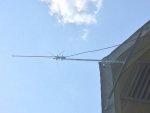Good advice from ab3a. You need to thoroughly check out the coax and connectors before you start chasing whether or not you moved into a "dead spot" or high interference area with the antenna. Another thought: You can very inexpensively acquire a simple spectrum analyzer / receiver; for about $25-35 including pigtail coax adapter you can buy a USB RTL-SDR stick receiver. And you will not need a transmitter or SWR meter for any of this. Install one of the free software programs on your laptop that turns the USB RTL-SDR stick into a VHF/UHF wideband receiver with waterfall display (HDSDR, SDR#, etc.) and plug it into your laptop. Connect to the end of the coax that is in the house. Take note of noise levels, signal levels, and take screen shots. Now head up to the roof with a good quality (9913, LMR400, etc.) short coax jumper and your laptop with the RTL-SDR setup. Disconnect the long coax from the rooftop antenna and replace it with the shorter coax jumper to your SDR laptop receiver. Launch the SDR software and take the same readings on the same channels and bands you did when in the house. Are the signal and noise levels for what you want to hear better, the same, or worse? If much better, then you likely have a coax problem in that long run - whether type of cable, connectors, moisture, short/open, etc. Are signals & noise levels about the same? Then probably not your coax, and you can start investigating the (possibly) high noise levels that you'll be able to see in the waterfall on the SDR software.


